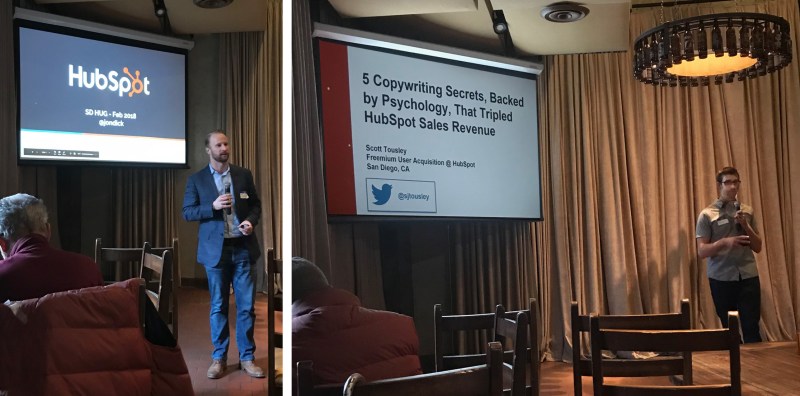Earlier this year I attended an interesting meeting of SD Inbound’s HubSpot User Group that had two educational speakers. Jon Dick from HubSpot gave a presentation about using chatbots in marketing, and Scott Tousley from HubSpot spoke about copywriting secrets based on psychology.

Chatbot takeaways
- HubSpot started experimenting with Facebook Messenger because so many people have it, especially on their phones. Message notifications pop up on screens, which has great visibility and ease compared to customers needing to click on a link or open an email.
- Though both Facebook Messenger and What’s App had 1.2 billion users in 2017, Facebook Messenger’s APIs are more open than What’s App so Facebook Messenger is used more often for chatbots and marketing messaging.
- Messenger can be used for lead generation, delivering offers, blog subscription opt-ins, site search, onsite messaging, and more.
- It’s cheaper to send ads through Messenger than buy Facebook ads or many other types of marketing.
- In one of HubSpot’s tests, people loved signing up for offers via messenger, while responding to a message with a funny gif and a link. This was a “skip the form and get a link via messenger” option on a landing page.
- You can send a QR code to customers via Messenger to sign in to an event.
- Pricing and product webpages are good places to have chat options, where people have navigated to with questions that could lead to an immediate sale. Blog pages are not good places to have chats available because blog visitors are probably not ready for interaction yet.
- If you’re a bot, you should say you’re a bot. Some chats are managed by humans, some are only automated responses, some are a combination of both. Be clear about when your chat is answered automatically and when a real person is on the other end.
Copywriting takeaways
- Pareto’s Law – 80% of output comes from 20% input. For copywriting, that 20% should include listening to the audience, conducting user interviews, recording the words customers use to describe your product or service, then testing those words in marketing. Scheduling customer interviews can be a challenge but it is an imperative part of discovering the right words to use for your product, service, or brand.
- The Zeigarnik Effect – it is psychologically uncomfortable to not finish something once you’ve started. This is why binge watching Netflix is so popular. “Opening the loop,” starting something, makes you watch it over and over until it is completed. Duolingo does a good job of using this effect by having you fill out a big survey at the beginning of the process before you even fill out your contact information. Then you are committed to completing the process and using the app after spending all that time starting the program. In marketing, you can A/B test an email with a whole blog post, compared to an email when you almost finish the post and create a button to read more.
- Maslow’s Hierarchy of Needs – many companies attach themselves to one of the specific needs. Charmin = physicological, Allstate = safety, Facebook = love & belonging, and Rolex = self-esteem, for example. Use a trigger, to spur an action, to receive a reward, in order to build customer habits.
- FOMO – fear of missing out. Fear is humanity’s most powerful motivator. Fear of loss is more powerful than the potential to gain. In marketing copywriting you can use FOMO with “the last possible one,” “you missed it,” subject lines or social posts.
- Auto-prospecting – finding and prequalifying leads automatically. Salespeople spend 40% of their time prospecting for clients, 40% of their time talking to people, and 20% of their time on admin work. Less prospecting and more talking to people would close more sales. When marketers write automated emails on behalf of salespeople, using a city in the signature based on that customer’s location, the salesperson’s prospecting time dropped to 5% and talking time increased to 75%.
- The liking principle – we are influenced more by people we like.
- The isolation effect – we remember things that stand out (isolation). “The ultimate risk is safety,” said Seth Godin, whose Purple Cow book about standing out was recommended.
Thanks to SD Inbound for the great seminar! I couldn’t make it to the national HUG Inbound event in April so I’m eagerly awaiting the next San Diego HUG meetup. What will I learn next?

